Houzz Survey: See the Latest Benchmarks on Remodeling Costs and More
If you’re about to embark on a remodel project, chances are you’ve already started asking yourself, How long will this take? And what should I spend my money on?
You’re not alone in considering a remodeling project. According to the fourth annual Houzz & Home survey, more than half (58 percent) of the 170,000 U.S. respondents renovated their homes in 2014, and more than half (55 percent) have concrete plans to continue or start renovations in 2015. That means there are countless people who have gone through what you have gone through — or are planning to go through this year. And we can learn a lot from one another.
To give you an inkling of what to expect, the survey offers insights into what you might pay for a renovation project, how long it will take and more.
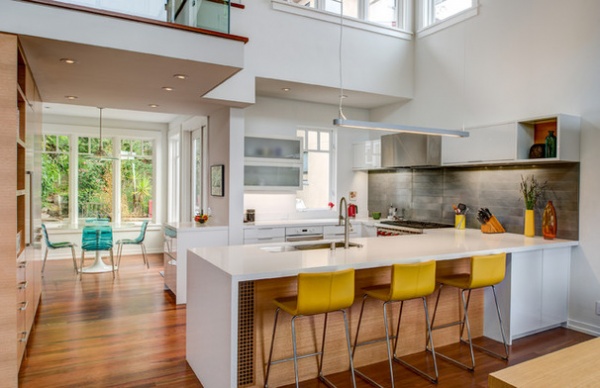
1. How much will a renovation project cost me?
It’s easy to set a budget, but harder to know exactly what a home design project will end up actually costing. Maybe you’ll discover a wall full of leaky old plumbing that needs replacing or your foundation will need work. These discoveries can make your carefully planned budget seem smaller than you thought.
A good way to start planning your remodel is by looking at what others have spent on their remodel projects.
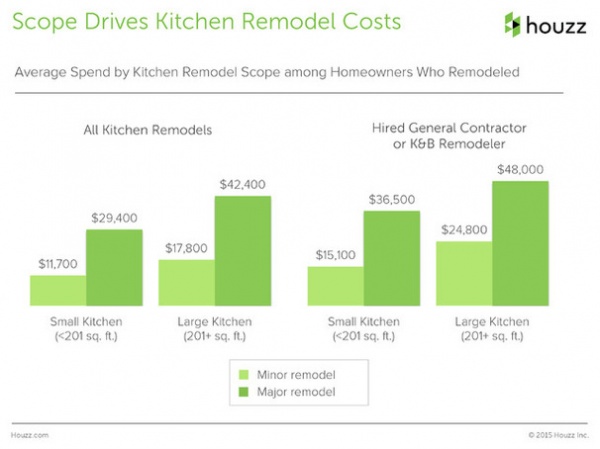
According to the Houzz & Home report, homeowners paid on average about $29,400 to remodel a small kitchen (less than 201 square feet) that was major in scope, which meant at least all the cabinets and appliances were replaced within the same home footprint.
A more minor remodel in the same-size kitchen averaged $11,700 nationally among surveyed homeowners on Houzz. For a large kitchen (more than 201 square feet), the average cost was $42,400 for a major remodel and $17,800 for a minor remodel.
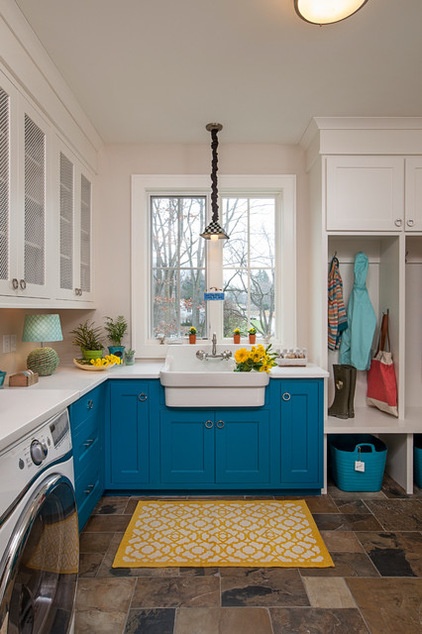
Again, this won’t tell you exactly what your project will cost, but it can give you a good benchmark. In other words, if you’ve budgeted just $5,000 for a kitchen remodel that involves new cabinetry and purchasing all-new appliances, you might want to rethink your numbers or the scope of your project.
Chicago interior designer Erin Shakoor cautions clients that kitchen and bathroom remodel costs can quickly add up. Unlike a living room or bedroom, where clients aren’t likely to get carried away adding thousands of dollars in throw pillows or drapery, kitchen add-ons can easily push budgets beyond expectations. The fixtures, materials and relocating of plumbing all come at a significant cost. “And believe it or not, pot fillers and TVs are becoming standards in kitchens these days, and everything drives the price up,” Shakoor says.
In line with most designers, she recommends setting aside 15 to 20 percent of your budget to absorb any unforeseen costs and budget shortfalls.
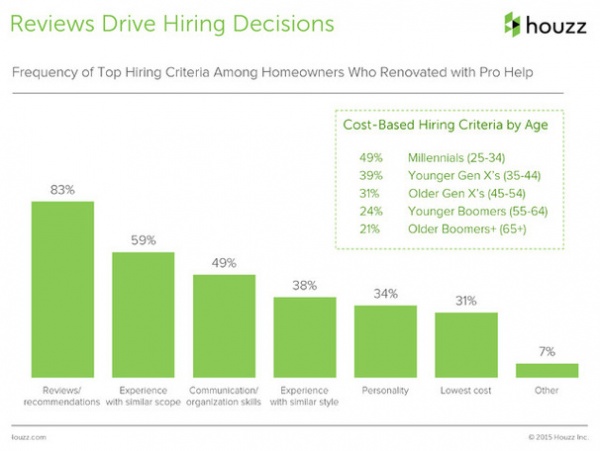
But the type of project isn’t the only thing that will determine the cost of your project. Age, it seems, is another indicator. Baby Boomers, those people above the age of 55, spend more on average for home remodel projects as Millennials, those between the ages of 25 and 34. (More than 15,000 U.S. Millennial homeowners participated in the survey.)
While Baby Boomers probably have more savings and financial security to pay for better materials, more professional services and so on, a look at the reasons each generation gives for hiring professionals gives a bit more context.
Reviews, experience with similar projects and communication skills top the reasons a homeowner chooses one pro over another. But Millennial homeowners are twice as likely as younger Baby Boomers (ages 55 to 64) to hire a professional based on the lowest cost bid.
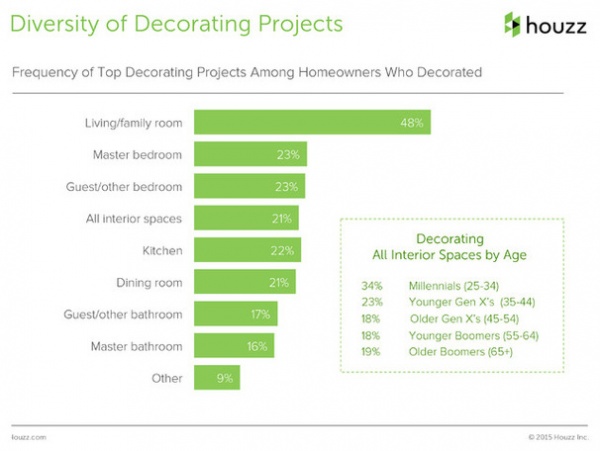
2. What should I spend my money on?
Not everyone has the time, money or need to tackle a major or even a minor renovation project. Two-thirds of homeowners decorated their homes in 2014, with nearly half (46 percent) having concrete plans to decorate in 2015.
Living rooms and family rooms are the most popular interior spaces to decorate, followed by bedrooms. One in five chooses to decorate all interior home spaces.
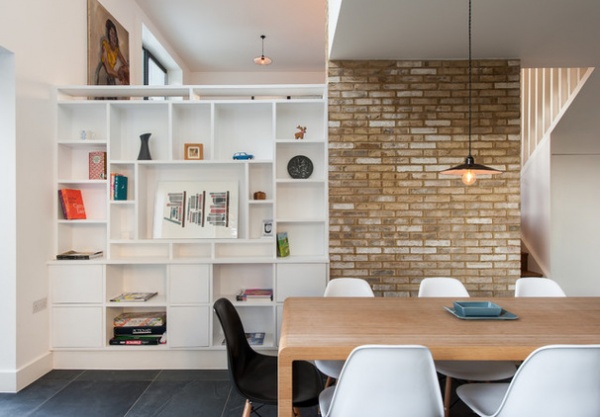
There are numerous reasons for renovations, and these no doubt span the extremes. Some people have to renovate because their homes were damaged by a catastrophic event (4 percent of renovating homeowners). According to the report, the top triggers for renovation in 2014 were wanting to do it all along and finally having the money and the time to do it.
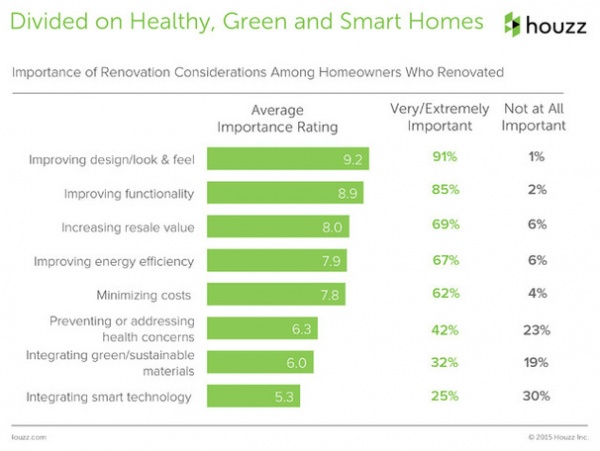
Not surprisingly, people’s top consideration during renovations is to live more comfortably. According to the report, 91 percent of renovating homeowners said improving the design, look and feel of their home was very or extremely important. Only 1 percent said it was not important at all. Furthermore, 85 percent of homeowners said improving the functionality of their home was very or extremely important. Just 2 percent said this wasn’t important at all.
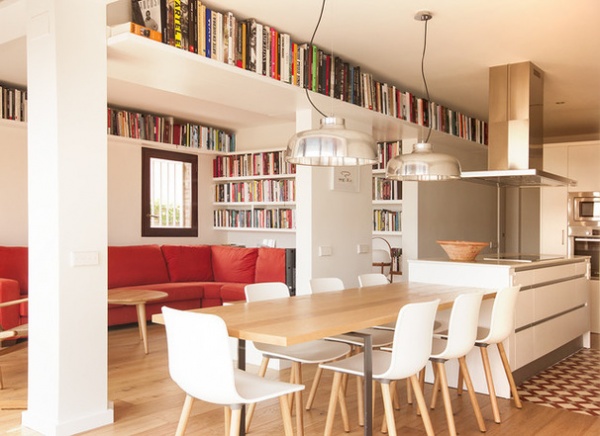
Resale value, of course, was big too. Nearly 70 percent of homeowners said they were renovating to increase resale value. What’s interesting, though, is that while this reason came in third, a very small percentage of people said resale value wasn’t important at all (only 6 percent). If you take this to heart, that means you should renovate your home for you, with look and function at the forefront, but keep resale value in the back of your mind.
So ask yourself what isn’t working for you in your home. Is the bathroom cramped for you and your spouse? Do you love cooking but get frustrated with the lack of counter space near your stove? These are good indicators of which spaces you should be putting your hard-earned money into. And if other homeowners are any indicator, you should run the resale scenario through your mind. Because you may want to sell sooner than you think. Mustard-yellow kitchen cabinets might make you pleased as punch, but could you be just as happy with a more neutral color?
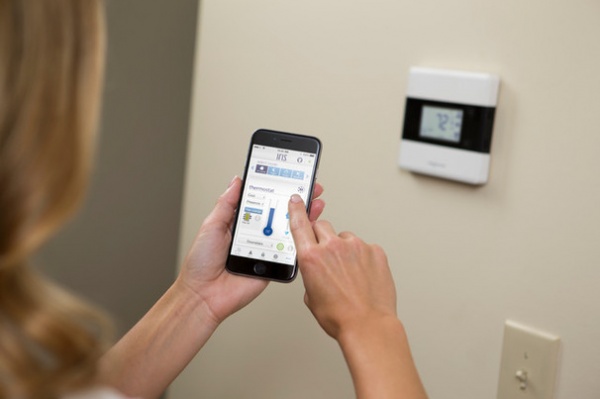
Homeowners appear to be more divided or unsure on healthy, green and smart-home technology. For example, a quarter of homeowners said integrating smart technology is extremely important, versus 30 percent who said it’s not important to them at all.
Michael Wolf, an analyst at NextMarket Insights, a research and consulting company, says home tech is an abstract concept that’s hard for people to wrap their minds around. “Companies are still in a phase of educating consumers, so a lot of people don’t quite get it yet,” he says. “But I think if you ask someone if they would want to be able to send a digital key to their mom’s phone so she can get into the house, they would say yes. That’s why there’s some hope with these big guys like Apple and HomeKit that’s raising awareness.”
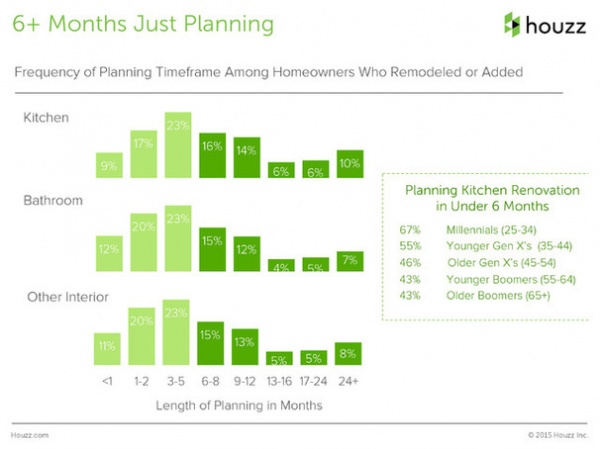
3. How long will it take to plan my renovation project?
Expect the planning phase of your renovation project to take around six months. Nearly a quarter of homeowners (23 percent) said their kitchen, bathroom or other interior project took between three and five months to plan, but the majority of homeowners said it took six to eight months. Sometimes it took up to two full years of planning before construction even began.
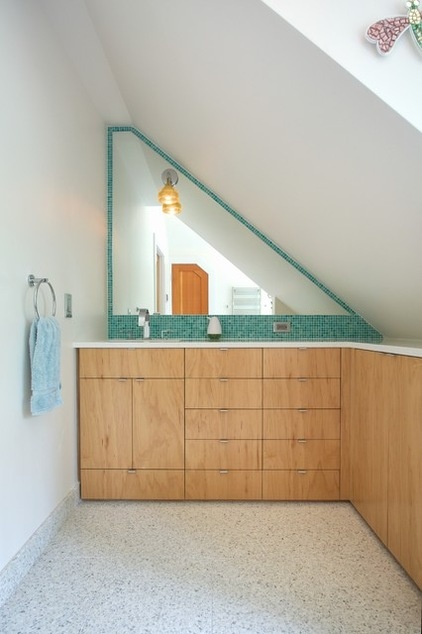
Age was a factor here, too, as the report showed that 67 percent of Millennials planned their kitchen remodel in under six months, while 43 percent of older Baby Boomers (over the age of 65) planned their project in the same time frame.
Shakoor says planning for a kitchen remodel should take three to four months if you’re working with a professional who can expedite the process of looking for products and materials. It could take a homeowner up to eight months if going at it alone. “With a design professional, you’re not looking at 20 different resources for the perfect glass tile,” she says. “A pro will have five resources, and we’ll pick the one that’s right for the budget.”
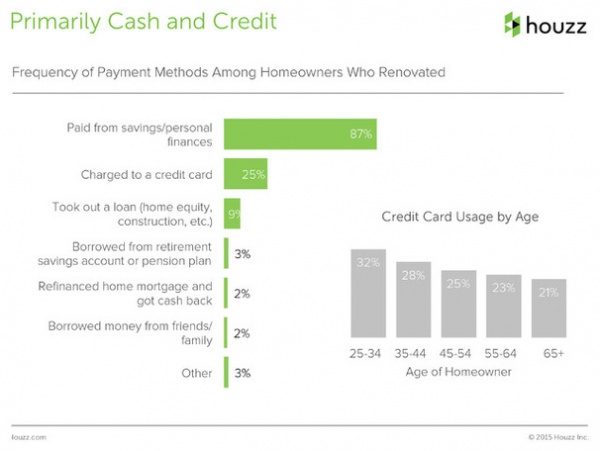
4. How will I pay for my renovation project?
There are several options when it comes to footing the bill for your project. But before you bust out that Visa card or take out a large loan, know that about a quarter of people chose to charge expenses to their credit card, and only 9 percent went the route of taking out a loan. The significant majority (87 percent) of homeowners pulled money from savings or their personal finances to fund their projects.
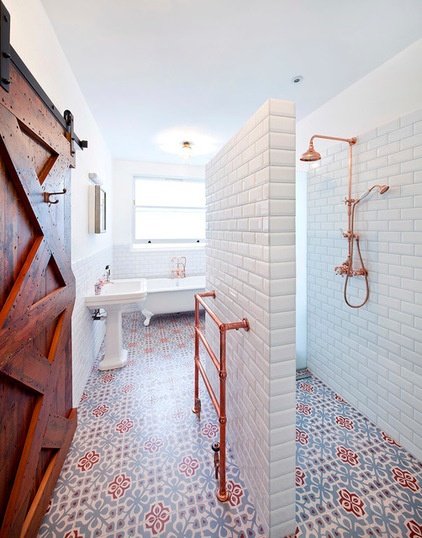
Again, percentages were different across generations. For example, 32 percent of Millennials used credit cards versus 21 percent of homeowners 65 and older. It’s important to do what’s best for your situation.
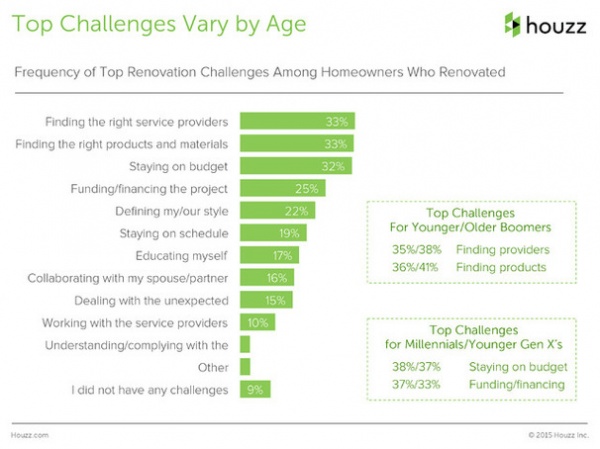
5. What will be the biggest challenge?
As mentioned earlier, there’s just no way of knowing what obstacles might arise during your project. But there are some common ones that most homeowners deal with time and again.
Finding the right service providers and finding the right products and materials proved to be the top challenges for 33 percent of homeowners. Staying on budget was also up there, with 32 percent of homeowners saying this was their top challenge.
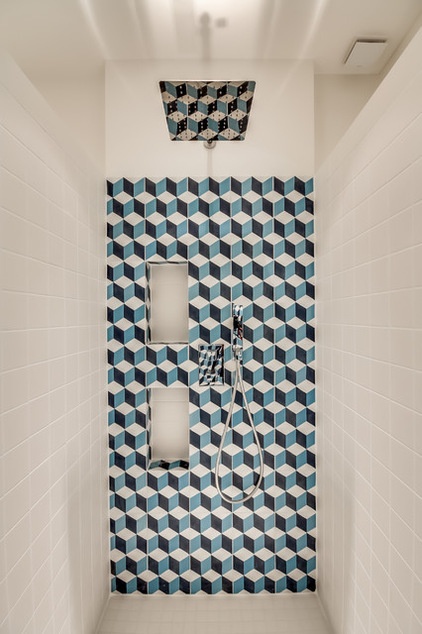
You can find leads on designers, installers and contractors by browsing local professionals’ projects on Houzz. Shakoor says homeowners should always conduct phone interviews, get three references of past clients and meet in person to find the right person for your project. “Always ask for work that’s been completed in the last two years,” she says. “A professional’s project may have started two years ago and recently finished. It’d be nice to know how it ended up and what all the ups and downs were.”
Other challenges will inevitably include dealing with the unexpected (hello, old plumbing in wall!), defining what your style is and collaborating with your spouse or partner.
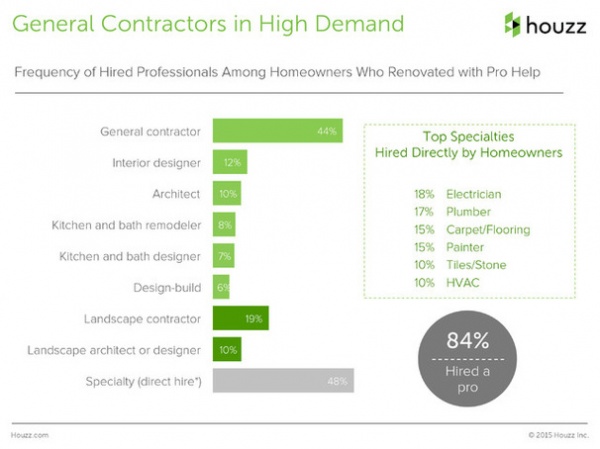
6. Should I hire a pro or do it myself?
Who hasn’t, at some point in their lives, imagined building or remodeling their home as a DIY project? It’s intoxicating to think of ourselves out of the office, in a woodshop, working with power saws and sanders. But most of us have only mastered the art of unlocking our smartphones with one hand. That’s probably why a whopping 84 percent of homeowners hired a professional to help with their remodel project in 2014, and 81 percent plan to hire a pro in 2015.
Nearly half of homeowners hired a general contractor (44 percent) or went directly to a specialty contractor (48 percent), including an electrician, a plumber, a painter and more.
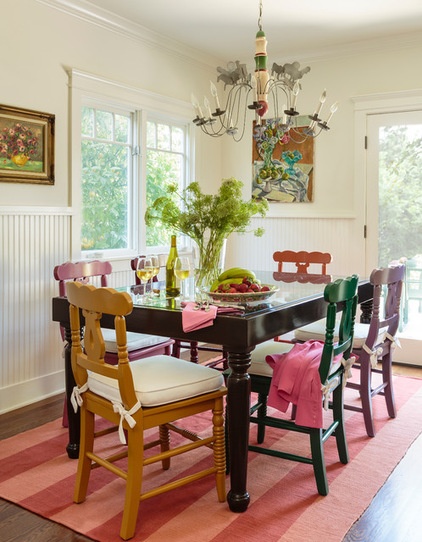
Hiring a professional can help save money and time on your project. “Paying a $5,000 or $10,000 design fee could save tens of thousands of dollars,” Shakoor says. “You might not be aware of a cabinetry line available for kitchens and baths that looks and performs like the higher-end cabinets your neighbors have and cost half as much.”
See the full report












